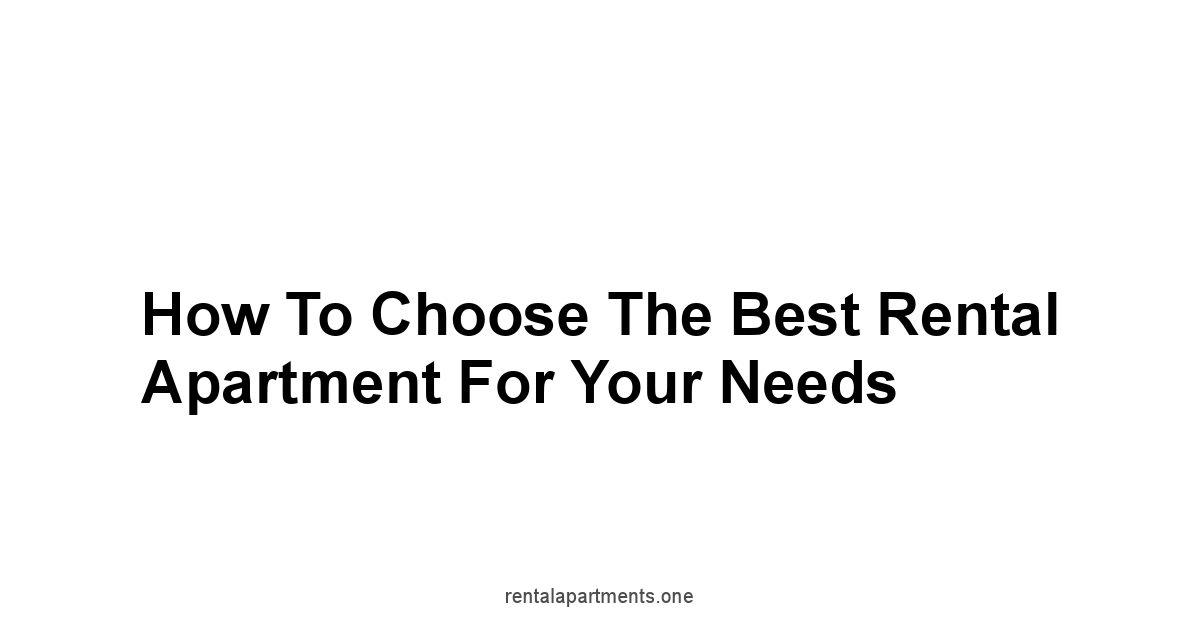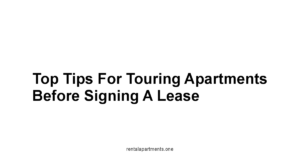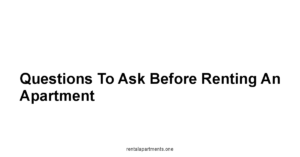Choosing the best rental apartment, it’s a serious hunt, not a casual stroll, and knowing your budget, your lifestyle and the must-have amenities are your compass.
Don’t start the hunt by looking at pretty pictures, instead, start with a good grasp of the numbers because a budget is a line in the sand, and if your rent exceeds 30% of your gross monthly income, you’re setting yourself up for trouble.
You also need to plan for security deposits, that can be the equivalent of one or two month’s rent, and moving costs such as application fees, moving truck rental, and utility hook-up fees which can easily add up to a couple thousand dollars, for example a first month rent could be around $1000 to $2500, a security deposit could be $1000 to $2500, application fees around $30-$75, not to mention moving costs like a truck rental that can be anywhere from $100 to $500, moving supplies from $50-$200, utility hook-up fees of around $50-$150, and of course, the renter’s insurance that you must have which can vary around $10-$30 per month, and don’t forget hidden costs like parking fees that can add a further strain to your budget, so plan well ahead or you’ll find yourself in the wrong type of place.
Think of your lifestyle and habits, if you thrive in a lively environment, you’ll need a completely different place compared to a remote worker needing quiet space.
Are you a social butterfly needing a big living room and easy access to the local night life, or a homebody seeking quiet, comfortable spaces? Maybe you’re a remote worker needing a designated workspace with good internet, or a fitness enthusiast needing a gym close by? If you are a pet owner, your needs are very different from a person without a pet, you will need to ensure that the building is pet-friendly and that the area is well suited for walks and play.
Make a table of your needs and rank each item based on your priorities like this:
| Lifestyle Aspect | Importance | Apartment Feature |
|---|---|---|
| Social Gatherings | High | Large Living Room |
| Quiet Time | High | Quiet Location |
| Work From Home | High | Designated Workspace |
| Fitness | Medium | Proximity to gym/park |
| Pet Ownership | High | Pet-Friendly Building |
| Cooking | Medium | Well-equipped kitchen |
| Privacy | High | Separate room or space |
Next comes the must have amenities like in-unit laundry, this is essential to avoid having to drag your laundry bags to the laundromat, and a dishwasher will help you save some time and keep away from germs.
If you have a car, parking is very important, and not all apartments offer free parking, some will charge extra.
Don’t forget about air conditioning or heating, depending on where you live, this is crucial for a comfortable experience.
And storage is also another important factor, do you need a walk-in closet, or extra storage space? A balcony or patio, will give you access to fresh air without leaving your apartment.
And of course, you might be one of those who needs a gym or pool within the building to save on gym membership costs.
Consider if you will need access to elevators or if you need pet friendly policies.
You might also require a secure entry system or dedicated areas for package reception.
Mark the following on a checklist for ease of reference, consider what is a must have and what is just desired:
| Amenity | Must-Have | Desired |
|---|---|---|
| In-Unit Laundry | ☐ | ☐ |
| Dishwasher | ☐ | ☐ |
| Parking | ☐ | ☐ |
| Air Conditioning | ☐ | ☐ |
| Storage Space | ☐ | ☐ |
| Balcony/Patio | ☐ | ☐ |
| Fitness Center/Pool | ☐ | ☐ |
| Elevator | ☐ | ☐ |
| Pet-Friendly Policies | ☐ | ☐ |
Do not ignore the location, because it can make or break the experience.
A perfect apartment in a bad neighborhood is a no-go.
Take a close look at commute time and accessibility, a long commute can steal your time and energy.
See if public transport is readily available, and consider the traffic patterns, you might want to test the commute at different times of day to see if it fits your routine.
Check also the safety and community vibe, feeling safe in your neighborhood is essential, look at the local crime statistics online, and see if the streets are well-lit at night, also check for community events or local groups, a strong sense of community will contribute to your sense of safety.
The distance to amenities is another factor to consider, how far is the nearest grocery store, are there parks nearby, and restaurants and cafes? Also consider healthcare facilities, shopping centers, and schools if you have children. Make a detailed plan for all of these factors.
Your apartment type and layout is crucial, don’t just go for the first thing you see.
Consider your options, a studio might work for a single person, while a family needs multiple bedrooms.
A studio is usually the most affordable and is good for people on a tight budget, but it does not have much privacy, a one-bedroom apartment offers more privacy, and might be better for couples.
A two-bedroom is good for roommates or small families.
And finally, three-bedroom apartments and more are designed for larger families or those that need extra space.
Also consider the layout of the apartment, is there an efficient flow, are the rooms big enough, is the kitchen functional, is the bathroom convenient and does the apartment have enough natural light? If you have special needs, this will also play an important role, is there wheelchair access, elevators, grab bars, and other things that may accommodate for your specific needs? Make sure to check the closet space, and kitchen storage, and if you need, if there are extra storage units available.
Before moving in, you must assess the apartment carefully, like a detective, check every little detail, don’t trust what you see at first glance.
You need to check the walls and ceilings for cracks and water stains, the floors for loose tiles or damages, check if the doors and windows open and close properly, that the plumbing is working and that there are no leaks, the electrical outlets are all working, and also all the light fixtures.
Check the appliances as well, refrigerator, oven, dishwasher, microwave, and washing machines, test everything to ensure it works.
Do not ignore natural light and ventilation, pay attention to where the windows are and if there is enough light, also check if the air flows well through the apartment.
Finally, take a close look for pests, check for droppings, nests, and holes. These things can make or break your experience.
If you take the time to do the research well, you are much more likely to find the best rental apartment for your needs.
Define Your Apartment Needs
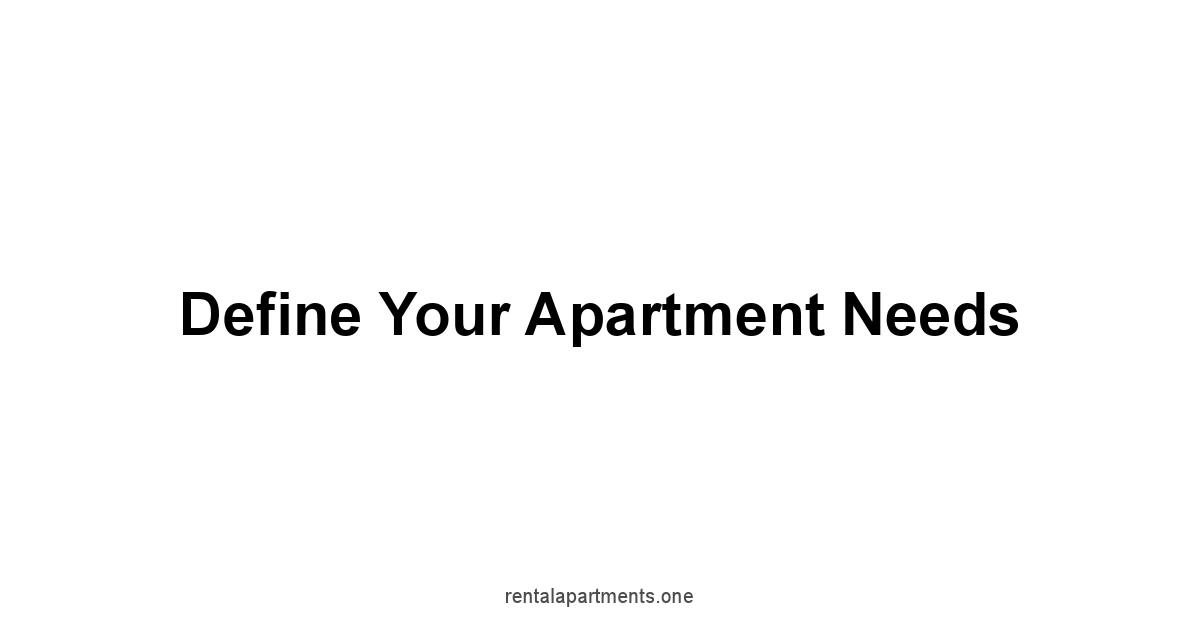
Finding the right apartment is like setting out on a hunt, you need to know what you’re after before you start.
It’s not just about finding a place to sleep, it’s about finding a place that fits your life.
You wouldn’t go fishing without knowing what kind of fish you want to catch, would you? Same goes for apartments.
Before you even start looking at listings, you need to nail down exactly what you need, not just what you want.
This will save you time and headaches down the road, ensuring you land in a place that feels like home, not just a temporary stop.
So, let’s get down to brass tacks.
Your journey starts with a clear understanding of what you’re looking for.
First, the budget is key, because if you chase after something you can’t afford, you’re not going to get it.
Then comes the kind of life you lead, which will dictate the type of space you’ll need.
And finally, what are the must-have extras that will make the apartment comfortable for you? Get these right, and you’re halfway to finding the perfect place.
Understand Your Budget
Money talks, especially when it comes to renting an apartment.
First things first, figure out how much you can realistically spend on rent each month.
It’s not just about the rent itself, you’ve got to think about utilities, internet, and any other recurring costs.
A good rule of thumb is the 30% rule: your rent shouldn’t be more than 30% of your gross monthly income.
Here’s a way to break it down:
- Monthly Income: Calculate your total income before taxes.
- 30% Rule: Multiply your gross income by 0.30 to see the maximum recommended rent.
- Other Costs: Add in estimated costs for utilities, internet, parking, and renters insurance.
- Total Monthly Housing Costs: This should be your actual monthly expenditure on housing.
It’s also important to factor in moving costs such as deposits, first month’s rent, and moving supplies.
Some places require a security deposit that can be equal to one or two months rent, and this needs to be ready before you even sign the lease. Here’s a simple breakdown of potential costs:
| Expense | Estimated Cost | Notes |
|---|---|---|
| First Month’s Rent | $1000 – $2500 | Depends on the location and size of the apartment |
| Security Deposit | $1000 – $2500 | Usually one or two months’ rent |
| Application Fee | $30 – $75 | Per applicant, often non-refundable |
| Moving Truck/Van | $100 – $500 | Based on distance and size |
| Moving Supplies | $50 – $200 | Boxes, tape, bubble wrap, etc. |
| Utility Hook-Up Fees | $50 – $150 | May include deposits for electricity, water, gas, etc. |
| Renter’s Insurance | $10 – $30/month | Can vary based on coverage. |
Don’t forget hidden costs that can sneak up on you such as parking fees.
Some apartments charge a monthly fee for parking and you must include that in the final calculations.
If you are living in an area where parking is hard to come by, you might also need to factor that into your expenses and budget.
Consider if you are going to need any furniture for your new place, even if it’s just a small new set of drawers, these will all add up to your moving costs.
Consider Your Lifestyle
Your lifestyle dictates a lot about what kind of apartment you’ll need.
Are you a quiet homebody who prefers a peaceful environment? Or do you thrive in a bustling urban setting with nightlife at your doorstep? These are crucial questions that will dictate where you start your search.
Your daily habits and hobbies should directly influence the type of apartment and neighborhood you choose.
A place that perfectly suits your lifestyle will make your life much easier.
Here’s a breakdown based on different lifestyles:
- The Social Butterfly: If you love having friends over, you’ll need a living room large enough to accommodate a group, maybe even a dining area. Proximity to social spots like bars, cafes, and restaurants is also essential.
- The Homebody: Look for a quiet area with a comfortable layout. A place where you can relax, recharge, and enjoy your time at home is key. Maybe you need a lot of space for your library or your crafts.
- The Remote Worker: You’ll need an apartment with a designated workspace, good internet, and minimal distractions. A separate room or a corner that can be converted to an office is key, depending on the amount of people you are living with, and whether you have a roomate you might consider how much they will disturb your work routine.
- The Fitness Enthusiast: Proximity to a gym, park, or other fitness facilities is important. You might also want to consider the possibility of storing your bike, yoga mat, and other workout equipment.
- The Pet Owner: Make sure the building allows pets and consider if there’s a nearby park or space for your pet to exercise and play. You will need to ensure that the building allows pets and whether there are any associated costs to keeping your pets in the property.
Think about your daily routines and habits and make a list of what’s most important for you. A table might help you outline your priorities:
Consider what kind of atmosphere you’re looking for.
Do you prefer the quiet of the suburbs, or the hustle and bustle of a city center? Also consider noise, if you are a light sleeper you will want to choose an apartment that is on a quieter street or on the top floor.
Identify Must-Have Amenities
Amenities are the cherries on top of an apartment, and while they’re not always a necessity, they certainly make life more convenient and enjoyable.
A must-have for one person might be a luxury for another, so think about what really matters to you.
Don’t get distracted by the fancy features that you may never use.
It is important to focus on the amenities that will positively affect your lifestyle.
Here are some common amenities to consider:
- In-Unit Laundry: A big convenience. Nobody likes lugging laundry bags to the laundromat and it can also be a big time saver.
- Dishwasher: This saves time and effort after meals, also reduces contact with germs if you are avoiding washing dishes by hand.
- Parking: If you have a car, secure parking is important. Some apartments provide parking spaces at an extra cost, or it might be free depending on the building.
- Air Conditioning/Heating: Essential for year-round comfort. Some areas will be much hotter or colder than others, and the costs of the utility bills may be something you will need to consider.
- Storage Space: Do you need a walk-in closet, or additional storage in the form of extra cupboards?
- Balcony/Patio: A great way to enjoy some fresh air and relax outdoors without leaving the premises.
- Fitness Center/Pool: If you prefer working out on premises or you like to swim, these facilities can help save on costly gym memberships.
Consider also building amenities like:
- Elevator: If you prefer to not use stairs, or for ease of use, an elevator is essential. Especially if you have children or older people living with you, this can be extremely useful.
- Pet-Friendly Policies: Necessary if you have a pet, along with pet-friendly amenities.
- Security: A secure entry system, or on site guard, these can provide peace of mind.
- Package Reception: Some buildings have dedicated areas or staff to accept parcels.
- Common Areas: Common areas such as rooftop terraces, or lounge areas, might improve your experience.
Here’s a checklist you might find helpful, mark the must-haves and desired:
List out your must-haves, the things you absolutely need in order to feel comfortable in the apartment.
Also, make a list of the desired amenities, the ones you would like, but you are willing to live without.
This list will greatly help you prioritize your searches.
Location Matters: Choosing the Right Neighborhood
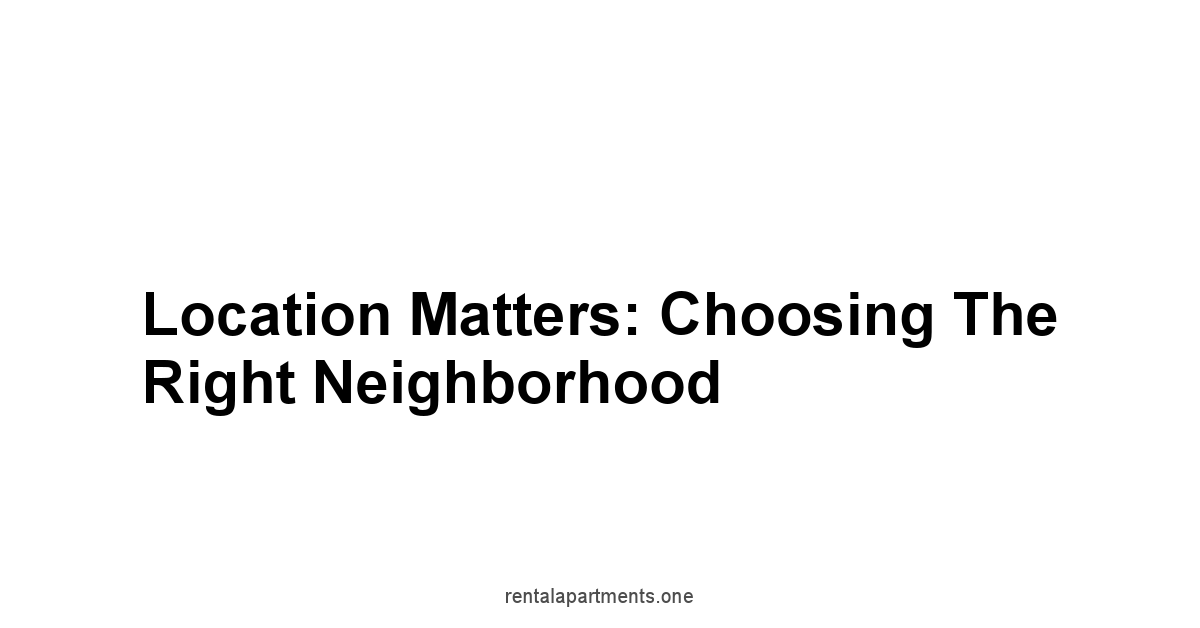
Location is like the setting of a good story, it can make or break the experience.
You can find the perfect apartment, but if it’s in a neighborhood that doesn’t fit your lifestyle, you might not be comfortable there.
Think of your neighborhood as an extension of your apartment.
You are not just renting the space within those four walls, you are also renting the environment around it.
You will be walking those streets, going to those stores, and spending time in the surrounding community. Choose it wisely.
The best neighborhood for one person might be the worst for another.
Someone who enjoys the hustle and bustle of city life will find the suburbs too boring and quiet, while someone who enjoys peace and quiet might be driven crazy by the noise in a city center.
Take your time to get a feel for the area, don’t rush to rent the first place that you see, and try to find a place that complements your lifestyle.
Commute Time and Accessibility
Your commute can easily make or break your day.
A long and tedious commute can wear you down, stealing valuable time and energy, while a short and easy commute will improve your overall lifestyle and reduce stress.
Think about how you will travel to and from work, or school.
Is public transportation readily available? Can you walk or bike? Also consider how long it will take you to reach your regular places you frequent.
These things all need to be planned ahead of time to avoid potential problems after the move.
Here’s what to consider when evaluating commute time and accessibility:
- Proximity to Work/School: How long will it take you to get to work or school? A shorter commute means more time for other things.
- Public Transportation: Is there easy access to buses, trains, or subways? Check the schedule and make sure they align with your daily routine. A good idea is to do a mock commute during the same time you would usually go to work, to see if that will align with your schedule.
- Walkability/Bikeability: Can you walk or bike to nearby places? This can be a great way to save money and stay active. Look out for pedestrian-friendly areas and bike lanes.
- Traffic Patterns: Check out the traffic during peak hours. A neighborhood might look great at 2 pm but might turn into a traffic jam at 8 am. Use online map services to view typical traffic times and plan your commute.
- Parking Availability: If you have a car, is parking available? Is it free or is it costly? Check out the parking situation and make sure it fits into your budget.
- Accessibility to Major Highways: If you drive a lot, easy access to major highways can save you time and stress. Look out for how long it will take you to reach these routes.
Here’s an example of a commute analysis table:
| Location | Mode of Transportation | Commute Time | Cost Per Month |
|---|---|---|---|
| Apartment to Work | Car | 30 Minutes | $150 gas |
| Apartment to Work | Bus | 45 Minutes | $80 pass |
| Apartment to School | Bike | 15 Minutes | $0 |
| Apartment to Local Gym | Walk | 10 Minutes | $0 |
| Apartment to Parents | Train | 60 Minutes | $100 pass |
Keep in mind that your commuting needs may change in the future, and you need to look at the location not only for the present but also for the future.
The easier your commute, the more time you have to pursue your hobbies or enjoy a better work-life balance.
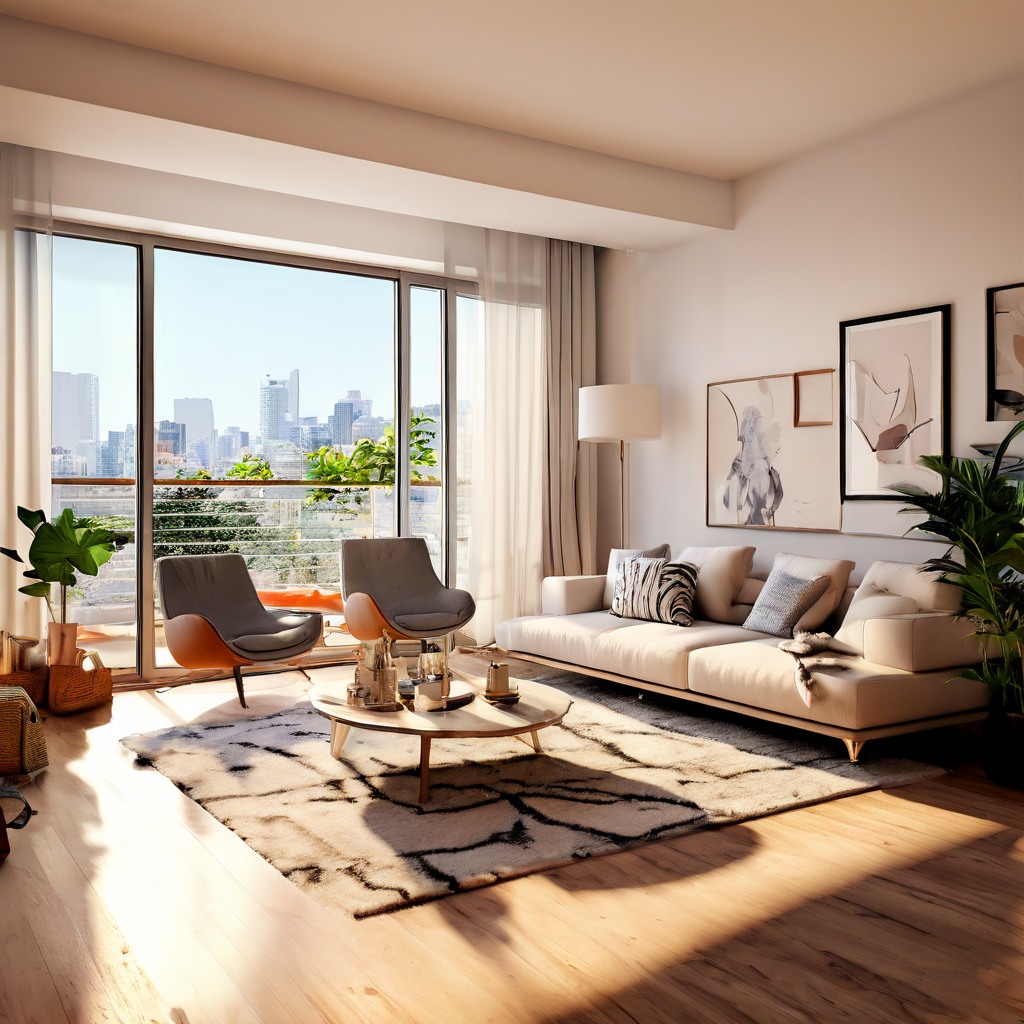
Safety and Community Vibe
Feeling safe and comfortable in your neighborhood is key to enjoying your living experience.
A good neighborhood can contribute positively to your mental well-being.
You are not just looking for a place to stay, but a place that feels like home, and safety plays a big part in that equation.
The character of a community is also a big influence on your experience.
Here’s what to consider when evaluating safety and community:
- Crime Rates: Check local crime statistics online, or through local police databases. You can look out for specific types of crimes that might concern you, such as burglaries or vandalism.
- Street Lighting: Are the streets well-lit at night? This is a crucial factor that affects the safety of the neighborhood.
- Community Engagement: Are there community events or local groups? This often means that it’s a strong and well connected community that looks out for each other.
- Noise Levels: How loud is the neighborhood during the day and night? Some places are more lively than others. Check at different times to get a sense of the area.
- Local Opinions: Talk to residents in the area and get their opinions. They are the best resource for getting a real-life view on how the area is.
- Appearance: How well maintained are the properties and public spaces? A well maintained environment is usually a sign of a well cared for community.
Use the following checklist to assess the neighborhood:
| Aspect | Evaluation | Notes |
|---|---|---|
| Crime Rate | ☐ Low | Check local crime statistics online and with police. |
| Street Lighting | ☐ Adequate | Visit the area at night to see how well lit the streets are. |
| Community Events | ☐ Present | Look for community events or local groups, this is a good sign of a thriving community. |
| Noise Levels | ☐ Moderate | Check noise levels during the day and night. |
| Local Residents | ☐ Friendly | Talk to people who live in the neighborhood and ask about their experiences. |
| General Upkeep | ☐ Good | Note the state of the buildings and public spaces, does it look well taken care of? |
You also need to pay attention to the general feeling of the neighborhood when you visit.
Do you feel at ease? Do you feel you belong there? First impressions are important, and if you don’t feel safe or comfortable, it’s probably best to keep looking.
Proximity to Amenities: Groceries, Parks, and More
Convenience is king, and having amenities nearby makes daily life easier and more enjoyable.
You don’t want to have to drive 20 minutes just to get a loaf of bread.
You also need to consider things like parks, and public spaces as these will improve your quality of life.
A good neighborhood will offer the amenities you need without unnecessary effort.
Here’s what to consider when evaluating proximity to amenities:
- Grocery Stores: How far is the nearest grocery store? A nearby supermarket will help save you time and effort on grocery shopping.
- Parks and Recreation: Are there nearby parks or green spaces? Parks can be great for a walk, run, or just to relax in nature.
- Restaurants and Cafes: Are there plenty of dining and coffee options? Being close to restaurants and cafes will greatly improve your convenience.
- Healthcare Facilities: How close are hospitals, clinics, and pharmacies? Healthcare accessibility is very important and should be prioritized.
- Shopping Centers: How close are shopping centers, and are there different options? This is very important for those who regularly shop at malls.
- Entertainment Venues: How far are movie theaters, podcast venues, or other forms of entertainment? If you like to go out for entertainment on a regular basis, you should look out for these options.
- Schools: If you have children, how close are good schools? This is a big consideration for families, and should be prioritized.
Use a table to evaluate the proximity of amenities:
| Amenity | Distance/Time | Notes |
|---|---|---|
| Grocery Store | 5 Minutes Drive | Check out the prices and quality of goods at the store. |
| Park | 10 Minutes Walk | Are there other amenities at the park such as playgrounds? |
| Restaurants/Cafes | 2 Minutes Walk | Are there various types of cuisine available? |
| Healthcare Facilities | 10 Minutes Drive | Are they easily accessible by public transport? |
| Shopping Centers | 15 Minutes Drive | How much variety do the shopping centers provide? |
| Entertainment | 20 Minutes Drive | Check what kind of entertainment venues are nearby and what they offer. |
| Schools | 10 Minutes Walk | Are they well rated? Check local ratings |
Don’t just look at the proximity of the amenities but also the quality.
It’s no use having a grocery store around the corner if it’s always out of stock, or a park that’s badly maintained.
Look for a balance of convenience and quality that works for you.
Also note the type of stores around, for example a very expensive grocery store is not as useful to someone on a budget.
Apartment Types and Floor Plans: Finding the Right Fit
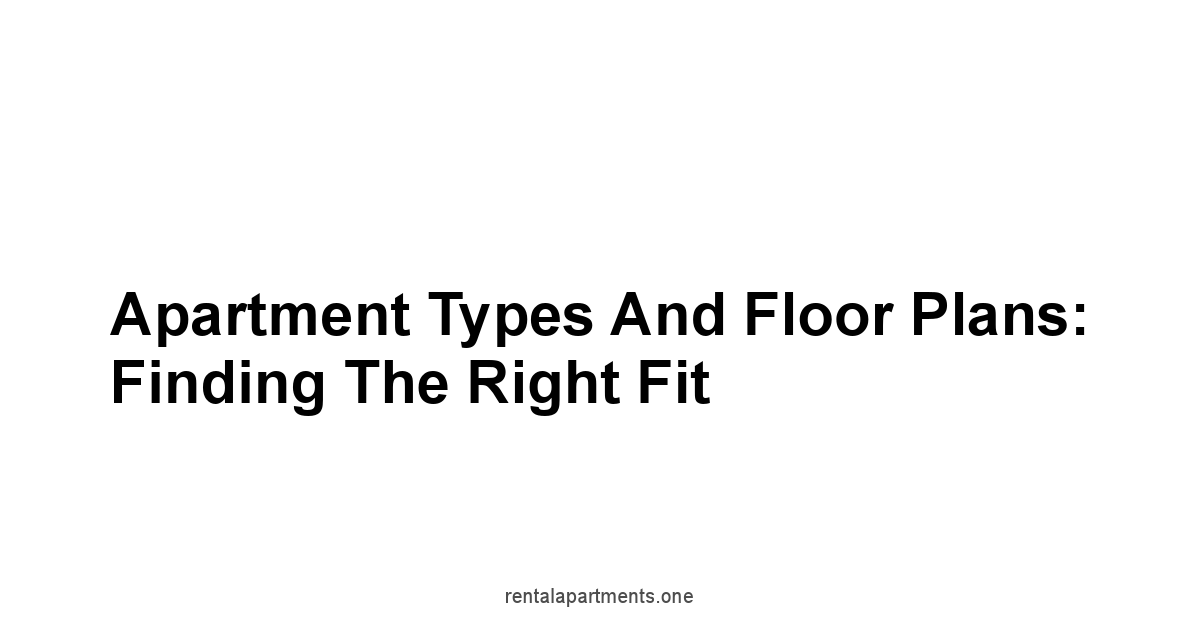
The layout of your apartment is as important as the location, like choosing a tool for a specific job, you need the right type of space to fit your needs.
A studio might be just right for one person, while a family might need a much larger space.
Understanding the different apartment types and layouts will ensure that your apartment is not just a space to sleep but a space that works in harmony with your lifestyle.
Finding the right fit is not about picking the first apartment that looks good, it’s about finding the apartment that will be the most comfortable for you.
Choosing the right apartment type and floor plan is about more than just square footage, it’s about how the space flows and how it will fit your daily routine.
The wrong layout can make a space feel cramped, while the right layout can make even a smaller apartment feel spacious and functional.
Take your time to really understand how you will use the space and pick an apartment that is suited to your personal preferences.
Studio, One-Bedroom, or More?
The number of rooms in an apartment is a good starting point when assessing your needs.
Studio apartments, one-bedroom apartments, or multiple bedrooms, each have their benefits and drawbacks.
Your choice will largely depend on the amount of people you live with, your budget, your needs, and the desired level of privacy you are looking for.
There are no good or bad apartment types, only the one that best suits your situation.
Here’s a breakdown of different apartment types:
- Studio Apartment: A single, open space that includes the living room, bedroom, and kitchen. Studios are usually the most affordable and can be a good choice for single people or those with a tight budget. They are easy to clean and require less furniture. However, there is a lack of privacy, and may not be ideal for having guests, as there will be no space to entertain them without moving your furniture around.
- One-Bedroom Apartment: This includes a separate bedroom from the living area, offering more privacy than a studio. It’s a good choice for couples or single people who want more space and privacy. It’s often more expensive than a studio, but offers more convenience.
- Two-Bedroom Apartment: This is ideal for roommates, small families, or those who need a home office or guest room. It provides a good balance between cost and privacy. There is more space for common areas and enough privacy to accommodate multiple people.
- Three-Bedroom Apartment or More: This is usually the option for larger families or those who need a lot of space. These are the most expensive and usually the largest spaces.
Here’s a table to help compare different apartment types:
| Apartment Type | Ideal For | Pros | Cons |
|---|---|---|---|
| Studio | Single individuals, budget-conscious tenants | Affordable, low maintenance, easy to clean | Lack of privacy, limited space, less storage |
| One-Bedroom | Couples, single professionals | More privacy, separate living area, ample space | More expensive than studios, limited for larger families |
| Two-Bedroom | Roommates, small families | Good balance of cost and space, more privacy | May require furniture purchases to fill larger spaces, more cleaning |
| Three-Bedroom+ | Larger families | Ample space, privacy, ideal for families | Most expensive, high maintenance, requires more upkeep |
Think about your current needs and also consider potential changes in the future.
If you are planning to start a family, you will want to plan accordingly and look out for bigger apartments.
Some apartments may also be set up to be convertible, for example a living room that has partitions, to make it into a make-shift bedroom.
Understanding Floor Plan Layout
The floor plan is the roadmap of your apartment.
It shows how the different rooms and spaces connect.
A well-designed floor plan can significantly enhance the functionality of the apartment.
A bad floorplan can lead to less space and an inefficient use of the area.
It is important to take into consideration how you will use the spaces in your apartment, and choose a floorplan that will maximize the amount of utility you get out of it.
Here’s what to consider when evaluating floor plan layouts:
- Flow of Space: How well do the rooms flow into one another? Is it easy to move from the living room to the kitchen? An efficient flow of space will reduce clutter and unnecessary walking.
- Room Sizes: Are the rooms big enough for your furniture? Make a list of your furniture dimensions to be sure the rooms can accommodate them without overcrowding.
- Kitchen Layout: Is the kitchen functional? Does it have enough counter space, storage, and a good layout?
- Bathroom Placement: Is the bathroom easily accessible from all parts of the apartment? It is good if the bathroom is accessible to guests without having to go through your bedroom.
- Privacy: Are bedrooms located away from the main living areas? It is important that you are comfortable in your own space, and your bedroom is not next to the living room where you have guests.
- Natural Light: Where are the windows located, and how does this affect natural light in the apartment? It is ideal to have plenty of natural light to help save on energy costs.
Here’s a list to help assess floor plans:
| Floor Plan Aspect | Evaluation | Notes |
|---|---|---|
| Space Flow | ☐ Efficient | Make sure the apartment is easy to move through |
| Room Sizes | ☐ Adequate | Check measurements and make sure the rooms are big enough for your furniture |
| Kitchen Layout | ☐ Functional | Make sure there is enough counter and storage space |
| Bathroom Placement | ☐ Convenient | Is the bathroom easily accessible from different rooms? |
| Bedroom Privacy | ☐ Sufficient | Are the bedrooms located away from high-traffic areas like the living room? |
| Natural Light | ☐ Good | Are there enough windows? And does the natural light reach most areas in the apartment |
Look at a few different floor plans before choosing the right one.
Some apartments are built with a bad flow, or they may have small bedrooms or too much space in areas that are not as useful.
You should take the time to go over these details to make sure you find something that is just right for you.
Special Needs: Accessibility and Storage
When it comes to finding the right apartment, special needs can be a big factor.
Whether it’s mobility issues or a need for extra storage, it is important that your apartment is accommodating for your personal requirements.
Accessibility and storage might be afterthoughts for most people, but for some, they are very important.
It is important that you take your special needs into consideration so that you choose the right apartment that will suit all your specific needs.
Here are some considerations for accessibility:
- Wheelchair Accessibility: Are there ramps, wide doorways, and roll-in showers? These are very important if someone is using a wheelchair.
- Elevators: If the apartment is not on the ground floor, is there an elevator? Make sure the elevator is in working condition, as it might not work from time to time.
- Grab Bars: Are there grab bars in the bathroom? If there is an elderly person living with you this might be crucial to their mobility.
- Door Handles and Faucets: Are these easy to use for someone with arthritis? These small details can make a big difference in day to day life.
- Staircases: Are there staircases that might be an impediment for someone with mobility issues?
Here are some things to consider for storage:
- Closet Space: Is there enough closet space for your belongings? Make sure to have a look in all of the closets to see if they can accommodate all of your things.
- Kitchen Cabinets: Are there enough kitchen cabinets for your pots, pans, and other items? Open and close the cabinets to see if they are easy to operate.
- Storage Units: Are there additional storage units available, if needed? Most complexes offer extra storage spaces for an additional monthly fee.
- Under-Bed Storage: Is there space under the bed for extra storage? This is great if you are in a small apartment, as this helps save some space.
- Balcony/Patio Storage: Can you store things on the balcony or patio? Some landlords will not allow for extra storage outside the apartment and this will be in your contract.
Here’s an assessment list for special needs:
| Special Need | Evaluation | Notes |
|---|---|---|
| Wheelchair Access | ☐ Adequate | Ramps, wide doorways, roll-in showers if needed. |
| Elevator | ☐ Present | Essential if the apartment is not on the ground floor. |
| Grab Bars | ☐ Available | If required, they should be properly installed and in good condition. |
| Door Handles | ☐ Easy to Use | Especially if mobility is an issue. |
| Closet Space | ☐ Sufficient | Make sure you will have enough space for all your belongings. |
| Kitchen Storage | ☐ Adequate | Enough space to store all your kitchen items. |
| Extra Storage | ☐ Available | Storage units or balcony storage can be an extra help if needed. |
Don’t be afraid to bring up specific requirements with your landlord or property manager.
Most landlords are willing to work with you to meet your needs, but you have to make them aware.
Finding an apartment that accommodates your special needs will greatly improve your living experience.
Assessing the Apartment: What to Look For
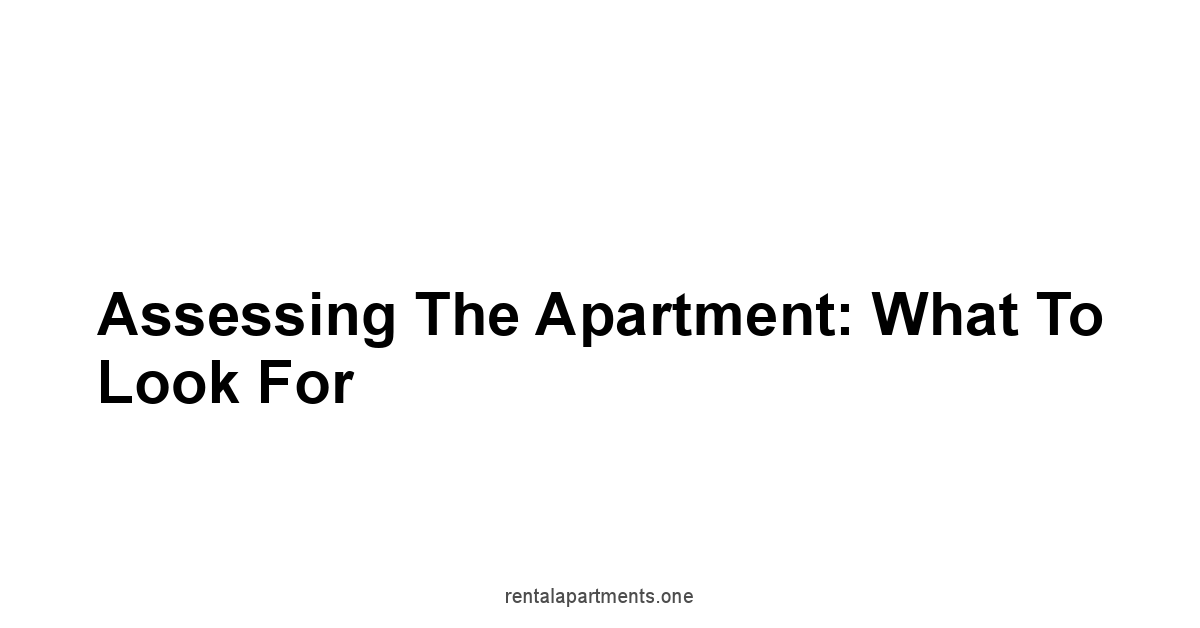
Once you’ve narrowed down your search, it’s time to take a close look at the apartment itself.
This is where you become a detective and look for all the signs.
You’re not just walking through the door, you’re assessing every nook and cranny. It’s like inspecting a car before you buy it.
You wouldn’t buy a car without looking under the hood, would you? The same goes for apartments.
You have to make sure everything works and is in good condition.
Don’t let a fresh coat of paint fool you.
You need to look beyond the surface to identify any potential issues.
This thorough inspection will help you avoid unpleasant surprises down the line.
You might find some minor issues that you are happy to accept but some issues might be deal-breakers.
Do not feel the pressure to choose the first apartment you see, take your time and make sure the apartment is right for you.
Check for Damage and Repairs
It’s crucial to look for any existing damage or necessary repairs before moving in.
You don’t want to be held responsible for damage that was already there when you moved in.
Take the time to look at everything and make a detailed list so that you can discuss these things with your landlord.
It is also helpful to take some pictures as evidence.
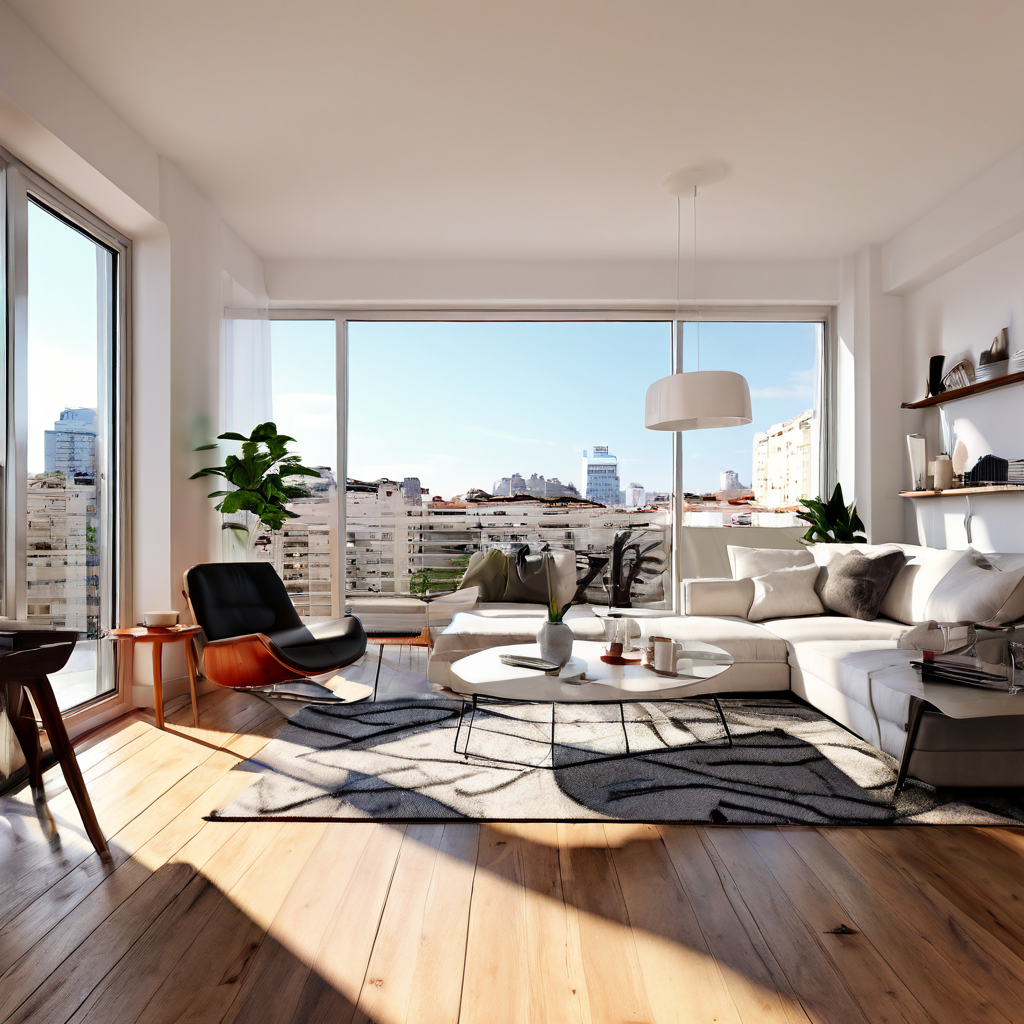
Here’s what to check:
- Walls and Ceilings: Look for cracks, water stains, or signs of mold. Small cracks are usually not too much of a problem, but large cracks can be an indication of underlying problems.
- Floors: Check for loose tiles, warped wood, or damaged carpets. Pay attention to any uneven areas that might cause you to trip and fall.
- Windows and Doors: Check if they open and close properly. Look for gaps or drafts. Windows and doors that don’t close properly can be a security risk, and could also contribute to increased utility costs.
- Plumbing: Check for leaks under sinks and around toilets. Turn on the taps to see if the water pressure is good. Also check how the drainages work.
- Electrical Outlets: Make sure all outlets work. Bring a phone charger to test them. Check if the outlet plates are damaged or hanging loose.
- Light Fixtures: Make sure all lights work and that the fixtures are in good condition. Look out for any flickering lights, or ones that do not work.
Here’s a checklist for damage and repairs:
| Area | Damage/Repair Needed | Notes |
|---|---|---|
| Walls and Ceilings | ☐ Yes/No | Cracks, water stains, or mold present? |
| Floors | ☐ Yes/No | Loose tiles, warped wood, damaged carpet? |
| Windows and Doors | ☐ Yes/No | Properly open and close? Gaps or drafts? |
| Plumbing | ☐ Yes/No | Leaks, water pressure issues? |
| Electrical Outlets | ☐ Yes/No | Do they all work? Damaged or loose plates? |
| Light Fixtures | ☐ Yes/No | Working properly? Damaged fixtures? |
Make notes of everything and document it with photos or videos.
Share your findings with your landlord before signing the lease, so there will be a record of the damage that was already present when you moved in.
Be thorough with your inspection, this is your chance to document any issues, so you are not held responsible when you move out.
Evaluate Appliances and Fixtures
Appliances and fixtures are a crucial part of the apartment.
Before signing a lease, you should check everything to make sure it works.
A non-working refrigerator or stove can greatly impact your day-to-day life.
Make sure to test all the appliances and fixtures to avoid potential headaches.
- Refrigerator: Make sure it cools properly. Check the temperature settings, and that all the shelves are present.
- Oven/Stove: Test all burners and the oven to see if they heat up correctly. Check if they have all their accessories.
- Dishwasher: Check if it runs properly. Make sure it drains and does not leak.
- Microwave: Test to make sure it heats up. Is the plate rotating correctly?
- Washing Machine/Dryer: Check if they run and drain, and that all their settings work.
- Bathroom Fixtures: Check that faucets and showerheads work and don’t leak. Also test the water pressure.
- Toilet: Make sure it flushes properly. Check for leaks around the base.
Here’s a table to help with your appliance and fixture check:
| Appliance/Fixture | Functional? | Notes |
|---|---|---|
| Refrigerator | ☐ Yes/No | Check if it cools, and if all shelves are present |
| Oven/Stove | ☐ Yes/No | Test all burners and the oven functions |
| Dishwasher | ☐ Yes/No | Is it running and draining properly? |
| Microwave | ☐ Yes/No | Is the heating and rotating function in working order? |
| Washer/Dryer | ☐ Yes/No | Check all settings and that it drains properly |
| Bathroom Faucets | ☐ Yes/No | Check for leaks and water pressure |
| Toilet | ☐ Yes/No | Does it flush properly? Check for any leaks |
Don’t just assume that everything works, always test them yourself.
If you find any issues, make a note of it and let the landlord know.
You should not sign a lease until all the appliances are fully functioning.
If the landlord is willing to fix the issues, then you may consider choosing the apartment.
Consider Natural Light and Ventilation
Natural light and ventilation are often overlooked, but they play a big role in how you feel in your apartment.
A well-lit and well-ventilated apartment can greatly improve your mood and help save on your energy bills.
An apartment with poor natural light can feel gloomy and oppressive.
Natural light and ventilation will make your space feel more welcoming and comfortable.
Here’s what to consider:
- Window Placement: Where are the windows located? Are they facing the sun or the shade? South-facing windows usually get the most light, while north-facing windows get the least.
- Amount of Light: How much natural light enters the apartment? Observe the light at different times of the day.
- Airflow: Can you open the windows for ventilation? Is there a cross breeze, or does the air feel stuffy? Proper ventilation can reduce humidity, smells and make your apartment feel fresh.
- Window Size: Are the windows large enough to let in enough light? Small windows may not provide adequate illumination.
- Window Coverings: Are there blinds or curtains to control the light? Make sure you consider how you will cover your windows, in case the landlord does not provide them.
- Ventilation System: Is there proper ventilation in the kitchen and bathrooms? A well ventilated kitchen will make a big difference if you enjoy cooking.
Here’s a checklist for light and ventilation:
| Aspect | Evaluation | Notes |
|---|---|---|
| Window Placement | ☐ Good | Are they strategically placed to maximize light? |
| Amount of Light | ☐ Sufficient | Does enough natural light enter at different times of the day? |
| Airflow | ☐ Adequate | Can you open the windows? Does the air feel fresh? |
| Window Size | ☐ Sufficient | Are the windows large enough to let in enough light? |
| Window Coverings | ☐ Present | Blinds or curtains in place? |
| Ventilation System | ☐ Good | Do the bathrooms and kitchens have proper ventilation systems? |
Pay attention to how the light changes throughout the day and how the air moves around the apartment.
An apartment that feels bright and airy will greatly improve your comfort.
You should visit the apartment during different times of the day to gauge this properly.
Inspect for Pests
Pests are not something you want to deal with in your new apartment.
Infestations can be very difficult to deal with, and can lead to health problems.
Prevention is always better than the cure so it is important to take the time and check for signs of pests before you sign a lease.
A pest-free apartment will make your life much more comfortable.
Here are some things to look for:
- Droppings: Look for droppings in drawers, cupboards, and corners. This could indicate the presence of rodents or insects.
- Nests: Look for nests in hidden areas such as behind appliances or under sinks.
- Holes: Look for small holes
What do we think?
Choosing the right apartment is a process, not a sprint.
You’ve taken the time to define your needs, understand your budget, and consider your lifestyle.
Now, armed with checklists and a clear vision, you’re ready to make an informed decision.
It’s about finding a space that fits you, not forcing yourself to fit into a space.
Remember the 30% rule to keep your finances in check, and prioritize amenities that will simplify your routine and increase your comfort.
The goal is to create a home, not just rent an address.
Location is as crucial as the apartment itself.
The right neighborhood will make a difference to your quality of life.
It will affect your commute, your sense of safety, and the convenience of your day-to-day living.
Check the crime rates, talk to the locals, and explore the local amenities.
A neighborhood that’s a good fit for your lifestyle is as important as the apartment, and you need to consider it as an extension of your home.
Don’t underestimate the power of a good neighborhood in making you feel comfortable and at home.
The type of apartment and the floor plan should align with your living style and special needs.
Consider how the spaces flow, and if the rooms will suit your needs.
If you work from home you might want an extra room, and if you are a social butterfly you might need more living space for guests.
Take the time to consider all the features, and choose an apartment that supports your daily habits and routines, this will help you maximize your comfort.
Don’t underestimate the importance of having the right floor plan, it’s the key to making your space functional and comfortable.
Finally, never skip the assessment phase.
Check every corner for damage, test all the appliances and fixtures, and look at the natural light and ventilation.
Don’t assume that everything is perfect, take the time to look carefully at everything.
This is an opportunity to avoid problems down the road, and ensure you are choosing a safe and comfortable apartment.
This thorough examination will save you headaches later and ensure that you are moving into a place that’s truly ready for you to call home. Now, go find the right place, and make it yours.
Frequently Asked Questions
What’s the first thing I should do when looking for an apartment?
First, figure out your budget.
How much can you really afford? Then, think about how you live.
Are you a social butterfly or a homebody? This will guide your search.
What’s the 30% rule for renting?
Your rent shouldn’t be more than 30% of your gross monthly income.
It’s a simple way to keep your housing costs in check.
You need to have money for other things, not just the rent.
What are some hidden costs I should consider when renting?
Don’t forget about utilities, internet, parking fees, and even moving supplies.
These things add up, so you need to include them in your budget. A security deposit can be a surprise for some.
How does my lifestyle affect my apartment choice?
If you have a big social life you’ll need space to entertain, or if you work from home you’ll need a quiet spot. A place that fits your life is essential.
What if I have a pet?
Make sure the building allows pets.
Check for pet fees and nearby parks to make sure your furry friend is happy too.
What amenities should I look for?
Think about what you really need.
Do you need laundry in the unit? A dishwasher? Parking? Don’t get caught up in things you won’t use, choose the things that are useful for you.
How important is the location of the apartment?
Location is key, like the setting of a story. It can change everything.
Make sure the neighborhood fits your style of living.
What about commute times?
A bad commute can ruin your day, look for options near your job, or your school, consider walking, biking, public transportation. A shorter commute is better.
What should I look for in the neighborhood for safety?
Look into crime rates, street lighting, and talk to people in the area. You need to feel safe where you live.
Why is it important to check the apartment before signing the lease?
You need to be sure everything works. Check for damage, test appliances and fixtures. Don’t move into a place with problems.
What is important to look for in the apartment itself?
Check the walls, the floors, and the ceilings, look for any cracks and water damage.
Make sure that windows and doors close properly, check if the plumbing works, make sure to check all outlets.
How can I tell if an apartment has good light and ventilation?
Check where the windows are, look how much light comes in, and if there’s a good airflow when you open the windows. Natural light and fresh air are important.
What should I look for when inspecting for pests?
Look for droppings, nests, and small holes.
You don’t want to live with pests, so you should be aware of the signs.

